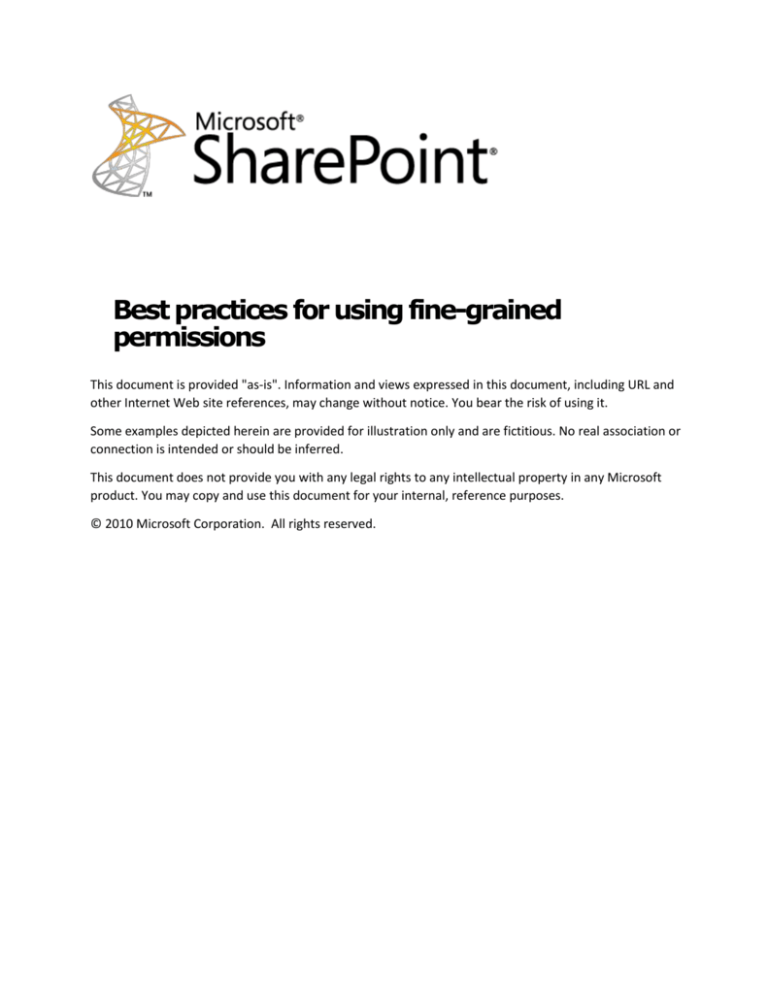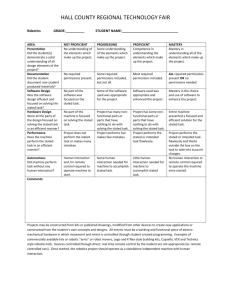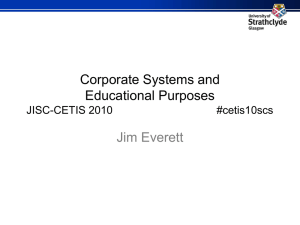
Best practices for using fine-grained
permissions
This document is provided "as-is". Information and views expressed in this document, including URL and
other Internet Web site references, may change without notice. You bear the risk of using it.
Some examples depicted herein are provided for illustration only and are fictitious. No real association or
connection is intended or should be inferred.
This document does not provide you with any legal rights to any intellectual property in any Microsoft
product. You may copy and use this document for your internal, reference purposes.
© 2010 Microsoft Corporation. All rights reserved.
Best practices for using fine-grained permissions
Writer: Sean Livingston, Product Manager, SharePoint Product Group
Published: September 2010
Summary: This paper describes best practices for fine-grained permissions (FGP) and how to use them within
your organization when using SharePoint® Products and Technologies or Microsoft® SharePoint® 2010
Products.
Page 2
Contents
Contents ................................................................................................................................................................ 3
Overview of using fine-grained permissions......................................................................................................... 4
SharePoint permission system overview .............................................................................................................. 5
Permission levels ............................................................................................................................................ 5
SharePoint groups .......................................................................................................................................... 5
Scope .............................................................................................................................................................. 5
Securable object ............................................................................................................................................. 6
Inheritance ..................................................................................................................................................... 6
Limited access................................................................................................................................................. 7
Binary ACL....................................................................................................................................................... 8
Best practices for avoiding common FGP limit issues .......................................................................................... 9
Too many scopes within a list ........................................................................................................................ 9
Too many members within a scope ............................................................................................................. 10
Very deep scope hierarchy ........................................................................................................................... 10
Recommended solutions for common FGP performance issues........................................................................ 11
Solution 1: Remove FGP and use security enforcement only at Web level ................................................. 11
Environmental security cleanup ............................................................................................................ 11
Environmental security architecture redesign ...................................................................................... 12
Solution 2: Use fine-grained permissions by hierarchical structure changes .............................................. 13
Environment hierarchy redesign ........................................................................................................... 13
Solution 3: Use fine-grained permissions by scope structure changes (2010 only) .................................... 14
Dynamic security changing code redesign ............................................................................................. 14
Environment architecture example .................................................................................................................... 15
Environment overview ................................................................................................................................. 15
Workflow design........................................................................................................................................... 17
Fine-grained permission issues .................................................................................................................... 17
Resolution of FGP issues............................................................................................................................... 18
Summary ............................................................................................................................................................. 20
Page 3
Overview of using fine-grained permissions
This article describes the use of fine-grained permissions (FGP) for SharePoint® 2010 Products (Microsoft®
SharePoint® Server 2010 and Microsoft® SharePoint® Foundation 2010) and SharePoint® Products and
Technologies (Office SharePoint® Server 2007 and Windows SharePoint® Services version 3.0); performance
issues related to FGP; and best practices for configuring solutions that include FGP.
Note: We recommend that you use FGP for only those business cases for which it is required. FGP can be
expensive in terms of both operational oversight and performance.
You can avoid the use of FGP by doing the following:
Break permission inheritance as infrequently as possible.
Use groups based on directory membership to assign permissions.
Note: We do not recommend that you use SharePoint groups to assign permissions to sites, because
when a SharePoint group is used to assign permissions, a full crawl of the index occurs. Instead, we
recommend Domain groups to be used.
Assign permissions at the highest possible level. As part of this strategy, consider the following
techniques:
o
Segregate documents that require fine-grained permissions into document libraries that are
defined to support each group of permissions, and keep the document libraries in a
segregated site collection or site. For additional information about hierarchical changes, see
Solution 2: Use fine-grained permissions by hierarchical structure changes.
Note: In this document, the terms Web and site equate to the SPWeb object, and site
collections equate to the SPSite object.
o
Use different document publish levels to control access. Before a document is published, the
advanced permissions and versioning settings can be set for users who can only approve
items in the document library.
o
For non-document libraries (lists), use the ReadSecurity and WriteSecurity permission levels.
When a list is created, the owners can set the Item-level permissions to either Read access or
Create and Edit access.
If you must use fine-grained permissions, consider the following recommended practices:
Ensure that you do not have too many items at the same level of hierarchy in the document libraries,
because the time necessary to process items in the views increases.
Use event handlers to control edit permission. You can have an event handler that registers an event
using the SPEventReceiverType.ItemUpdating and SPEventReceiverType.ItemUpdated methods,
and then use code to control whether the update should be allowed. This is extremely powerful,
because you can make security decision based on any metadata of a list or item, without affecting
the view rendering performance. For additional information about event handlers, see Resolution of
FGP issues.
Page 4
Use AddToCurrentScopeOnly method to assign Limited Access membership within a SharePoint
group. The key element in this principle is to redesign the architecture so that scope membership
does not cause ACL recalculation at the parent document library and Web. For additional information
about scope changes, Solution 3: Use fine-grained permissions by scope structure changes (2010
only).
SharePoint permission system overview
This section describes the SharePoint permissions scope system. For more information about planning site
security, see:
Plan site permissions (SharePoint Server 2010) (http://technet.microsoft.com/enus/library/cc262778.aspx)
Plan site permissions (SharePoint Foundation 2010) (http://technet.microsoft.com/enus/library/cc287752.aspx)
Plan site security (Office SharePoint Server) (http://technet.microsoft.com/enus/library/cc262778(office.12).aspx)
Plan site security (Windows SharePoint Services) http://technet.microsoft.com/enus/library/cc287752(office.12).aspx (http://technet.microsoft.com/enus/library/cc287752(office.12).aspx)
Permission levels
A permission level contains a set of individual permissions, for example, View Items or Create Alerts.
Permission levels can be predefined or created by the user. The set of permissions can be modified even
within the predefined permission levels.
SharePoint groups
A SharePoint group is a site collection-wide object that can hold other security principals, including Windows
user accounts, non-Windows users (for example, forms-based accounts), and Active Directory groups.
Scope
A scope is the security boundary for a securable object and any of its children that do not have a separate
security boundary defined. The scope contains an Access Control List (ACL), but unlike NTFS ACLs, a scope can
include SharePoint-specific security principals. The members of an ACL for a scope can include Windows
users, non-Windows users (such as forms-based accounts in SharePoint Products and Technologies or claimsbased accounts in SharePoint 2010 Products), Active Directory groups, or SharePoint groups.
There is no maximum number of scopes that can be created within a parent scope. However, in SharePoint
Products and Technologies, after 1,000 scopes have been created, a code path that requires additional
Microsoft® SQL Server roundtrips to analyze the scopes before rendering a view is used. When there 1,000 or
fewer scopes, only one roundtrip is required. In SharePoint 2010 Products, the limit of number of scopes
Page 5
returned before switching to a different algorithm is based on a query throttle limit, with a default value of
5,000; however this value even at default can be large enough to significantly detract from performance.
In SharePoint 2010 Products, there is a new method called
SPRoleAssignmentCollection.AddToCurrentScopeOnly, by which role assignment can occur. For additional
inforamation about role assignments, see SPRoleAssignmentCollection.AddToCurrentScopeOnly
(http://msdn.microsoft.com/enus/library/microsoft.sharepoint.sproleassignmentcollection.addtocurrentscopeonly.aspx).
Securable object
A securable object is an object that can have an ACL assigned to it. In SharePoint Products and Technologies,
the ISecurableObject interface can be used, and in SharePoint 2010 Products, the SPSecurableObject class
should be used. For additional information about securable objects, see ISecurableObject interface
(http://msdn.microsoft.com/en-us/library/microsoft.sharepoint.isecurableobject.aspx or SPSecurableObject
class (http://msdn.microsoft.com/en-us/library/microsoft.sharepoint.spsecurableobject.aspx).
Inheritance
If a securable object does not have a unique scope, the object inherits the scope of its parent. When an
object inherits from its parent, no scope is created for the object. Instead, whenever a security check is
made, it verifies only against the parent object. In the simplest environment, this scope is at the root Web of
the site collection that contains the item. When an item or container is changed to have unique membership,
its inheritance is broken, which means that a new scope is created for that item and, by default, for any of its
children that inherit its permission scopes.
The following diagram shows an object hierarchy for a document library, in which all objects but one inherit
their scope from their parents. Each numbered gold hexagon represents a permissions scope. All child
objects within a container inherit from that parent scope unless they have their own unique permissions
scope.
Page 6
Site Collection Object
1
Web Object
1
Web Object
1
Document Library Object
Folder Object
1
Item 1 Object
1
Item 2 Object
1
Scope 1
User 1 (Contributor)
User 2 (Reader)
User 3 (Limited Access)
User 4 (Full Control)
User 4 (Limited Access)
User 5 (Reader)
User 6 (Contributor)
AD Group X (Limited Access)
Scope 2
Item 2 Object
5
AD Group X (Reader)
User 3 (Contributor)
User 4 (Full Control)
Limited access
When a security principal is added to the scope of an item with unique permissions, the security principal is
immediately added with the Limited Access permission level to each unique permission scope in the
hierarchy above the item until a parent Web with unique permissions is located.
The reason for adding the user to the scopes with Limited Access is to allow enough access to the object
hierarchically above the uniquely permissioned item so that the Object Model (OM), master pages, and
navigation can render when the user attempts to navigate to the item. Without the Limited Access
permissions at the parent scopes, the user would not be able to successfully navigate to or open the item
that has unique permissions.
The following diagram shows how the hierarchical depth of scopes can affect the amount of work required to
add Limited Access users to parent scopes. The larger the number of unique scopes above the item, up to
and including the uniquely permissioned Web, the larger the number of additions that must occur. The
diagram shows a simplified representation of a physical structure that has unique scopes defined at every
level from the Web down to individual items. As in the previous diagram, each differently numbered gold
hexagon represents a unique permission scope, and all child objects within that container inherit from that
scope unless they have their own unique permissions scope. The chain of Limited Access promotion is shown
using red arrows.
Page 7
Scope 1
User 2 (Reader)
User 3 (Full Control)
User 6 (Contributor)
1
Web Object
1
Document Library Object
Folder Object
Item 1 Object
+ AD Group X (Limited Access)
+ User 3 (Limited Access)
+ User 4 (Limited Access)
+ User 5 (Limited Access)
+ User 1 (Limited Access)
+ User 2 (Limited Access)
2
3
Scope 2
User 5 (Reader)
+ User 2 (Limited Access)
Item 2 Object
4
+ User 1 (Limited Access)
Scope 3
User 1 (Contributor)
Item 3 Object
5
Scope 4
User 2 (Contributor)
Scope 5
AD Group X (Reader)
User 3 (Contributor)
User 4 (Full Control)
The diagram also includes the set of unique scopes along with the Limited Access membership additions that
must occur on each parent scope, represented by separate boxes within the scope. No additional
programming is required to add unique scopes whenever a security principal is added to an object scope with
unique permissions that is below a Web with unique permissions.
When a security principal with the Limited Access permission level is added to a parent scope, no check is
made to see whether the security principal is already in the parent scope. A security principal that already
has access to the parent scope is added again with Limited Access permissions, regardless of its existing
permissions on the parent scope.
When a security principal is removed from the Limited Access permission level at a parent scope, each
instance of that security principal within every child scope is removed from the Limited Access permission
level, regardless of whether the security principal has Limited Access or a wider set of permissions at the
child scopes.
Binary ACL
A binary ACL performs rapid comparisons of a user token to determine whether the user should have access
to the object covered by the scope. Whenever the membership of a scope changes, a binary ACL is
calculated, including when a new limited access member is added. The binary ACL takes more time to
Page 8
calculate as the membership gets larger, and access to the objects will be blocked until the ACL can be
recalculated.
Although there is no explicit size limitation on a binary ACL other than the maximum size of an image column
in SQL Server, some services cannot accept an ACL that is larger than 64KB. In this case, the number of
security principals in the binary ACL may be able to grow very large, but should be limited due to
performance and interoperability considerations. For information about limitations in image column sizes in
SQL Server, see ntext, text, and image (Transact-SQL) (http://msdn.microsoft.com/enus/library/ms187993.aspx).
Best practices for avoiding common FGP limit
issues
When working fine-grained permissions, it is easy to unintentionally encounter limits that prevent
permissions from resolving.
Too many scopes within a list
There is a built-in limit of 50,000 scopes per list or document library. After 50,000 scopes are reached
addition of new scopes within a given list or document library is prohibited.
In SharePoint 2010 Products, the built-in scope limit can be modified by using a Windows PowerShell script.
To modify the built-in scope limit to less than 50,000 scopes
1. Verify that you meet the following minimum requirements: See Add-SPShellAdmin
(http://technet.microsoft.com/en-us/library/ff607596.aspx).
2. On the Start menu, click All Programs.
3. Click Microsoft SharePoint 2010 Products.
4. Click SharePoint 2010 Management Shell.
5. At the Windows PowerShell command prompt, type the following syntax:
$webapp = Get-SPWebApplication http://serverName
$webapp.MaxUniquePermScopesPerList
$webapp.MaxUniquePermScopesPerList = <Number of scope limit>
Often, however, the effective limit is much smaller than 50,000 if many scopes exist at the same hierarchical
level. This is because display checks for items below that hierarchical level must be checked against all scopes
above them. This limitation can cause the effective number of scopes allowed in a particular query to be
reduced to 1,000 to 2,000.
Page 9
Best practices:
Only set unique scopes on parent objects such as folders.
Do not create a system with many uniquely permissioned objects below an object that has many
scopes.
If your business requires that you more than 50,000 uniquely permissioned items in a list or document
library, then you must move some items to adifferent list or document library.
Too many members within a scope
As described earlier, a binary ACL is calculated whenever the membership of that scope changes, including
when a new limited access member is added. As the scope membership number increases, the amount of
time it takes to recalculate the binary ACL increases.
However, the problem can be made worse as the additions of users at a child objects unique scope will cause
its parent scopes to be updated with the new Limited Access members, even if this ultimately results in no
change to the parent scope membership. When this occurs, the binary ACL for the parent scope(s) must also
be recalculated, at the expense of more processing time even if it ultimately results in the same ACL.
Best practice:
Rely on group membership instead of indivudal user membership in the scopes. For example, if a single
group can be used in place of 1,000 users, the scope will be 999 membership entries smaller for the scope
and any of its parent scopes which will be updated with Limited Access rights for that single group instead of
all 1,000 individual users with Limited Access rights. This additionally helps increase the speed of Limited
Access rights push and ACL recalculation at the parent scope objects.
Important: Using a SharePoint group will cause a full crawl of the index. If possible, use a domain group.
Very deep scope hierarchy
As indicated earlier, hierarchical depth of scopes can affect the amount of work required to add Limited
Access users to parent scopes. The larger the number of unique scopes above an item, up to and including
the uniquely permissioned Web, the larger the number of additions that must occur. If a scope hierarchy is
very deep, a scope membership change can take a very long time to occur, as each membership change in
the deepest scope item will have to iteratively update parent scopes with a membership addition for the
explicitly added user or group with Limited Access rights. Additionally this will increase the number of binary
ACLs that need to be recalculated, with an according performance impact.
Best practice:
Reduce the numbers of uniquely permissioned parent objects, thereby reducing the numer of scopes that
need to be updated with Limited Access members whenever any child objects scope changes.
Page 10
Recommended solutions for common FGP
performance issues
The following solutions can help mitigate performance issues that are specifically related to the extensive use
of fine-grained permissions. Each of the following covers changes to the environment security, object
hierarchy or custom code that is contributing tho the FGP related performace issue. Each solution will start
with the following example environment where a single Web contains multiple document libraries each with
a great many number of uniquely permissioned child objects.
1
Web Object
2
Document Library 1 Object
3
Folder Object
Item 1 Object
4
Item 2 Object
5
Item 3 Object
…
6
x10,000+ Items
(10,000 max per level)
Solution 1: Remove FGP and use security
enforcement only at Web level
To re-architect the environment so it no longer requires fine-grained permissions, an environment cleanup
process can be implemented, and then the number of scoped items can be adjusted to improve the
scalability of the environment over the longer term. The following recommendations describe the
environment cleanup and architectural security changes required to accomplish this solution.
Environmental security cleanup
When a user is removed from the Web-level scope, the internal OM must remove the user from every scope
below the Web level. However, removing individual users in order to clean up existing permissions is a timeconsuming process. Instead, first remove each of the individual item-level unique scopes so that the item is
set to inherit permissions from its parent object. This will take comparatively less time than attempting to
remove users first, because it has to act on only a single scope for the item.
Important: If the current Web is not at the root of the site collection, and if it is then set to inherit its
permissions from its parent Web, all the unique scopes under it will be removed, and all the Limited Access
memberships will be overwritten at once using in a single SQL Server roundtrip.
Page 11
1
Web Object
1
Document Library Object
Folder Object
Item 1 Object
Item 2 Object
1
1
1
Scope 1
SPGroup Object FullGP
+ FullControlGP (Full Control)
+ User 3
+ ContributorGP (Contributor)
+ User 4
+ ReaderGP (Reader)
SPGroup Object ContributeGP
Scope 2
+ User 1
User 5 (Reader)
+ User 2
+ User 2 (Limited Access)
SPGroup Object ReaderGP
+ User 1 (Limited Access)
Item 3 Object
1
+ User 5
Scope 3
+ AD Group X
User 1 (Contributor)
Scope 4
User 2 (Contributor)
Scope 5
AD Group X (Reader)
User 3 (Contributor)
User 4 (Full Control)
After all item-level scopes have been removed, individual scope memberships at the Web-level scope can be
replaced with one or more group memberships to allow access.
Web Scope
Web Scope
14,000+ unique entries (Limited Access)
Access Group (Contributor)
Environmental security architecture redesign
After the existing fine-grained permissions and scopes are removed, the long-term architecture plan should
be to maintain a unique scope only at the Web level. The following diagram shows how this could be
structured so that only the Web-level scope remains. The core requirement in the architecture is to not have
too many items at the same level of hierarchy in the document libraries, because the time necessary to
process items in the views increases. As a best practice, the maximum count of items or folders at any level in
the hierarchy should be roughly 2,000 items.
Page 12
1
Web Object
1
Document Library 1 Object
1
Folder Object
Item 1 Object
1
Item 2 Object
1
Item 3 Object
…
1
x10,000+ Items
(2,000 max per level)
If additional changes are needed to the architecture, consider moving document libraries to different Webs
or site collections. The number of document libraries could also be changed to more closely support business
needs and scaling recommendations that are based on the taxonomy or audience of the stored content.
Solution 2: Use fine-grained permissions by
hierarchical structure changes
To re-architect the environment so it still uses requires fine-grained permissions, but without causing
excessive updates to or or sizing of a single Web scope, consider moving differently secured document
libraries to different Webs.
Environment hierarchy redesign
In the following diagram, the physical architecture has been modified so that each document library is in a
uniquely permissioned Web. Additionally, when item-level FGP must be preserved, as a best practice the
cumulative number of security principals who will be granted access should be limited to approximately
2,000, although this is not a fixed limit. As such, the effective membership of each Web, including all Limited
Access members users, should be no more than approximately 2,000 users in order to keep each Web-level
scope from growing too large.
Page 13
1
Web 1 Object
2
Document Library 1 Object
3
Folder Object
7
Web 2 Object
Document Library 2 Object
8
Item 8 Object
9
Item 1 Object
4
Item 9 Object
10
Item 2 Object
5
Item 10 Object
11
Item 11 Object
12
Item 3 Object
…
x5,000+ Items
(2,000 max per level)
6
…
x5,000+ Items
(2,000 max per level)
The number of uniquely scoped children is not a significant issue, and can scale to large numbers, but the
number of principles that will be added as limited access up the chain of scopes to the first uniquely
permissioned Web will be a limiting factor.
Lastly, althoiugh not specifically an FGP issue, the folder structure should ensure that no single hierarchical
level of the document library ever exceeds roughly 2,000 items. This limit can help ensure good performance
of views requested by users.
Solution 3: Use fine-grained permissions by
scope structure changes (2010 only)
To re-architect the environment so it still uses requires fine-grained permissions, but without causing
excessive updates to or or sizing of a single Web scope, consider using a different process of securing items.
This is mainly applicable if the cause of the excessive number of unique scopes was through an automated
process such as an event handler or workflow that dynamically modified object permissions. The
recommendation in this case is to make a code change to whatever process was creating the unique security
scopes.
Dynamic security changing code redesign
In the following diagram, the scope architecture has been modified so that scope membership does not
cause ACL recalculation at the parent document library and Web. As mentioned earlier, the effective
membership of the Web, including all Limited Access members, should be no more than approximately 2,000
in order to keep the Web-level scope from growing too large. In this case, however, by implementing a new
SharePoint group to hold all members who should have Limited Access rights, the scope will not grow too
large. When users are added to individual scopes under the Web level, using the new SharePoint 2010
Products SPRoleAssignmentCollection.AddToCurrentScopeOnly method, they can also then be added, by
additional code, to the new group that has already been established as having Limited Access rights at the
Web and document library level.
Page 14
Scope 1
1
Web Object
1
Document Library Object
Folder Object
Item 1 Object
User 2 (Reader)
User 3 (Full Control)
User 6 (Contributor)
+ AccessGP1 (Limited Access)
2
3
Scope 2
User 5 (Reader)
+ User 1 (Limited Access)
Item 2 Object
4
+ User 2 (Limited Access)
SPGroup Object AccessGP1
Scope 3
User 1 (Contributor)
Item 3 Object
5
+ User 5
+ User 1
Scope 4
User 2 (Contributor)
+ User 2
+ AD Group X
+ User 3
+ User 4
Scope 5
AD Group X (Reader)
User 3 (Contributor)
User 4 (Full Control)
As mentioned earlier, when item-level FGP must be preserved, as a best practice the cumulative number of
security principals who will be granted access should be limited to approximately 2,000, although this is not a
fixed limit. As such, when this number increases, the amount of time it takes to recalculate the binary ACL
increases. If the membership of a scope is changed, the binary ACL must be recalculated. However, the
additions of users at a child item unique scope will cause parent scopes to be updated with the new Limited
Access members, even if this ultimately results in no change to the parent scope membership. When this
occurs, the binary ACL for the parent scope(s) must also be recalculated.
As in the previous solution, the number of uniquely scoped children is not a significant issue, and can scale to
large numbers, but the number of principles that will be added as limited access up the chain of scopes to the
first uniquely permissioned Web will be a limiting factor.
Environment architecture example
This section describes an example environment that was experiencing significant issues related to a
confluence of fine-grained permissions related issues, and covers the combination of solutions used to fix the
issue.
Environment overview
A knowledge management system based on SharePoint Server 2007 contained two site collections each with
a single Web, Contoso-Draft and Contoso-Production. Contoso-Draft was where initial drafts were published
and where workflows interacted with the documents. Contoso-Production was the final destination of each
approved document, and was the repository for all approved content.
Documents could be assigned to one of multiple content types that convey the intended purpose of the
document (such as project plans or troubleshooting guides). Additionally the documents were classified
Page 15
within technology domains (of which there couild be a hundred or more of increasing specificity), and for
various disciplines (such as project management or operations). The draft publishing site collection contained
one document library per discipline, each with a hierarchy of increasingly specifc folders for each technology
domain, and users were expected to first select into a discipline library and specific technology domain folder
when creating a new document.
The following diagram shows a simplified representation of the original physical structure of the Web, where
each uniquely numbered gold hexagon represents a unique permissions scope, and all child objects within
that container inherit from that same scope unless they have their own unique permissions scope.
1
Web Object
2
Document Library 1 Object
3
Folder Object
7
Document Library 2 Object
Item 8 Object
8
Item 1 Object
4
Item 9 Object
9
Item 2 Object
5
Item 10 Object
10
Item 11 Object
11
Item 3 Object
…
x10,000+ Items
(5,000 max per level)
6
…
…
x20
x10,000+ Items
(10,000 max per level)
Each combination of content type, technology domain, and discipline could have a non-overlapping reviewer
assigned who was an expert in the technology domain or discipline. The document library was expected to
hold a large number of items while they were undergoing workflow operations which dynamically changed
the assigned reviewer and security of the item. Once the document was final reviewed, it was then copied to
a matching Contoso-Production based location where it remained unmodified as a published version, and
available to all company employees.
For information about content type and workflow planning, see:
Content type and workflow planning (SharePoint Server 2010) (http://technet.microsoft.com/enus/library/cc262735.aspx)
Content types planning (SharePoint Foundation 2010) (http://technet.microsoft.com/enus/library/ff607870.aspx)
Plan content types (Office SharePoint Server) (http://technet.microsoft.com/enus/library/cc262735(office.12).aspx)
Plan content types (Windows SharePoint Services) (http://technet.microsoft.com/enus/library/cc287765(office.12).aspx)
Page 16
Workflow design
When the workflow process began, the author of a document was blocked from accessing it so others could
review it without the author making changes at the same time. For each succeeding step of the workflow,
the users who previously had access to the document were denied access and the reviewer(s) for the next
stage of the workflow were given access.
The workflow process used both a coded workflow and a custom event handler, which worked together.
When an item was changed in a document library, it was initially acted upon by the custom event handler
which would change permissions and start a new workflow instance. Both the workflow and the event
handler changed the permissions for the specific file being updated, so that each item was given a unique
permissions scope. This permission change meant that only a single user or small subset of users—that is, the
reviewers for that step, had access to the item at a time. The final step in the workflow, once the document
was fully approved, was to copy it to the equivalent Contoso-Production location as a new published version
of the document, with permissions inheriting from the parent Web.
Fine-grained permission issues
The environment and workflow design tested well during development, but is now experiencing signficant
issues in performance, with users experiencing delays from one to dozens of minutes before tasks can be
accomplished. The testing used only hundreds of test accounts, but once the design was made available and
and then announced as a mandatory knowledge capture tool for the entire company, usage quickly grew to
greater than 15,000 users cumulatively working on over 30,000 documents. The performance issues reported
prevented a large portion of the company from being able to use the new knowledge management system
which was expected to support upwards of 60,000 users.
When the permission changes happened through the workflow, a permission scope was created for each
individual item. Following the requirements of the Limited Access permission level as described previously,
each unique security principal was added with Limited Access to the various unique permission scopes in the
hierarchy above the item until a uniquely permissioned Web was located. Therefore, the more unique scopes
that were above the uniquely permissioned item but below the uniquely permissioned Web, the more scopes
that the security principal was added to with Limited Access.
Web Scope
15,000+ unique entries (Limited Access)
Item Scope
User 1 (Contributor)
Item Scope
User 2 (Contributor)
Item Scope
AD Group X (Reader)
…
x30,000+ Scopes
x15,000+ Unique Users
Page 17
A key thing to be aware of here is that the problem is not due to the sheer number of unique scopes that
have been created within the site collections root Web, but that the effective number of unique security
principals within that Web-level scope has grown to over 15,000 unique users. Each user added to any
unique permissions scope below the Web was also added to the Web’s own scope, which caused a binary
ACL recalculation for each addition.
Due to the large size of the Web-level scope combined with the frequency of binary ACL recalculation can
cause blocking in several SQL Server stored procedures. Each time an item with broken inheritance has its
membership scope changed, it causes each member of the scope to be added as a having Limited Access user
membership at the Web-level scope. Additionally, each each time the membership of the Web scope was
updated with existing or new members, including for Limited Access, it caused a recalculation of the Weblevel scope binary ACL. Due to the Web-level scope containing over 15,000 security principals, it took a long
time to recalculate. While it was recalculating, no access was available to that object, and end users
experienced intermittent login difficulties.
Resolution of FGP issues
The previously mentioned soltions were considered as part of the process of mitigating the experienced FGP
related performance issues, with both a short term and long term plan enacted. The short term decision was
to refactor the workflow to no longer set per item FGP, and the environment structure was left hierarchically
the same. The individual FGP scopes were then removed, initially by attempting to remove each user from
the Web scope or item level scopes, but as the performance was unsatisfactory, a removal process for each
item scope was enacted by having the item inherit permissions from its parent. Additionally, some content
rebalancing was used to prevent too many items from displaying at a specific level of hierarchy.
The event handler was modified to enforce a form or read access for those not currently assigned as
reviewer by preventing modifications to documents or workflows. This approach did not limit who could view
items, because there is no way other than the use of scopes to securely restrict viewing, but it could be used
to prevent modifications to documents or workflows, such as for example, mistakenly allowing the author to
modify the document while it was in a review cycle. Once individual item security scopes had been removed,
and the updated workflow and event handler were installed users were able to use the environment, minus
the individual item level security enforcement with no further performance issues.
The following diagram shows a simplified representation of the physical structure of the Web after security
scope removal, where each uniquely numbered gold hexagon represents a unique permissions scope, and all
child objects within that container inherit from that same scope unless they have their own unique
permissions scope.
Page 18
1
Web Object
1
Document Library 1 Object
1
Folder Object
Item 8 Object
1
Item 1 Object
1
Item 9 Object
1
Item 2 Object
1
Item 10 Object
1
Item 11 Object
1
Item 3 Object
…
1
…
x10,000+ Items
(2,000 max per level)
…
1
Document Library 2 Object
x20
x10,000+ Items
(2,000 max per level)
A planned longer-term solution in SharePoint Products and Technologies would be to separate content into
different Webs, so that FGP could continue to be used, but with overall impact limited to a much smaller set
of changes.
The following diagram shows a simplified representation of the physical structure of the content after
separating to different Webs, where each uniquely numbered gold hexagon represents a unique permissions
scope, and all child objects within that container inherit from that same scope unless they have their own
unique permissions scope.
1
Web 1 Object
2
Document Library 1 Object
3
Folder Object
7
Web 2 Object
Document Library 2 Object
8
Item 8 Object
9
Item 1 Object
4
Item 9 Object
10
Item 2 Object
5
Item 10 Object
11
Item 11 Object
12
Item 3 Object
…
x10,000+ Items
(2,000 max per level)
6
…
…
x20
x10,000+ Items
(2,000 max per level)
The following diagram shows the logical scope design and highlights the limits of how many unique security
principals could be added to each Web's scope if FGP was reena bled after moving to different Webs. Note
that although a large number of uniquely permissioned items still would remain, the key issue of excessive
numbers of security principals in a scope is solved.
Page 19
Web Scope
Maximum 2,000 entries (Limited Access)
Item Scope
User 1 (Contributor)
Item Scope
User 2 (Contributor)
Item Scope
Group X (Reader)
…
x10,000+ Scopes
x2,000 Unique Users
Lastly some consideration was made for when an eventual switch to SharePoint 2010 Products would bring
new capabilities to the workflow design, specifically the ability to dynamically assign FGP by using the
SPRoleAssignmentCollection.AddToCurrentScopeOnly method to assign membership only to each items
individual scope, and then granting a SharePoint group, containing the membership, Limited Access at the
parent Web. This process would enable FGP to be implemented via the workflow and/or event handler
without impacting performance.
Summary
This paper describes best practices on how your organization can use fine-grained permissions and what
potential performance issues can occur. It additionally covers strategies and processes to mitigate issues if an
environment is currently experiencing issues due to improper use or scale of fine-grained permissions. Lastly,
it covers an example environment that was experiencing issues from improper fine-grained permissions use,
and the process used to fix the issues found.
Page 20








